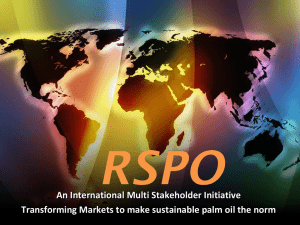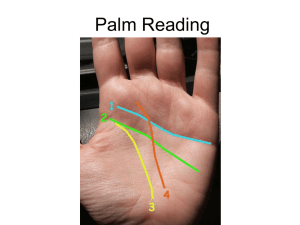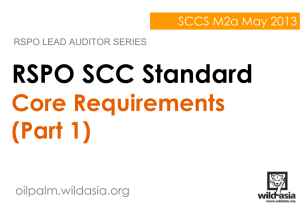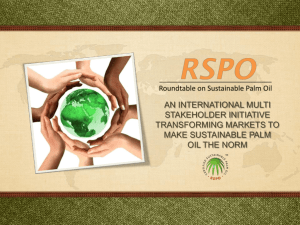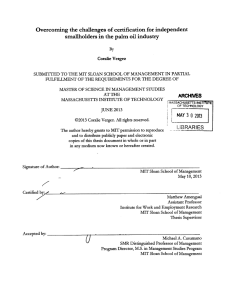Why palm oil? - Roundtable on Sustainable Palm Oil
advertisement
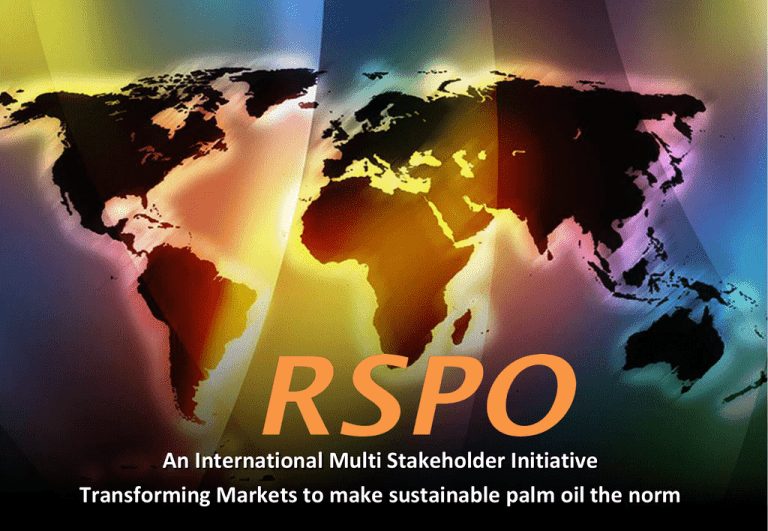
An International Multi Stakeholder Initiative Transforming Markets to make sustainable palm oil the norm Outline What is palm oil? The need for certified sustainable palm oil The Roundtable on Sustainable Palm Oil (RSPO) Where we are today Where we go from here What is palm oil? “It has the scent of violets, the taste of olive oil and a color which tinges food like saffron but is more attractive” Ca’da Mosto, 15th century explorer, on discovering palm oil. Why palm oil? Palm Oil is…. A highly versatile vegetable oil Used in many food and non-food products Produced in tropical countries Rapidly growing market share World’s top selling vegetable oil • Palm oil is used in more than half of packaged supermarket products today Growth of world’s palm oil production 50 40 30 20 10 0 1966 1976 1986 1996 2006 Palm oil – world’s number one vegetable oil Others 19% palm oil 30% Sunflower 8% Rapeseed 14% Soy 29% palm oil soy rapeseed sunflower others Top palm oil producing countries 47% 39% 14% indonesia malaysia others Asia and Europe are world's major importers of palm oil (2009) China Other Africa Europe Asia India Pakistan Other Asia Advantages of palm oil • are highly efficient producers of oil • require less land than other oil crops Average yield per year (tonnes of oil per hectare) 0.36 Soybean 0.42 Sunflower 0.59 Rapeseed Oil Palm 3.68 0 1 2 3 4 Why sustainable palm oil? • More than 1 million workers • More than 3 million smallholders • Many more household members • Social issues in oil palm cultivation • Land ownership conflicts • Worker’s rights and conditions • Treatment of smallholders • Environmental issues in oil palm cultivation • Forest, peatland conversion • Climate change • Biodiversity loss THE RSPO • • • • About the Roundtable on Sustainable Palm Oil: Established in 2004 Began with 7 members International Multi-stakeholder not for profit association Promotes the growth and use of sustainable oil palm products through global standards 8 FUNDAMENTAL PRINCIPLES & 39 CRITERIA Principle 1: Commitment to transparency; NGO Principle 2: Compliance with applicable laws and regulations; Principle 3: Commitment to long-term economic and financial viability; Principle 4: Use of appropriate best practices by growers and millers Principle 5: Environmental responsibility and conservation of natural resources and biodiversity Principle 6: Responsible consideration of employees and of individuals and communities affected by growers and mills (case study) Principle 7: Responsible development of new plantings Principle 8: Commitment to continuous improvement in key areas of activity 8 PRINCIPLES & 39 CRITERIA 1. 2. 3. 4. 5. Commitment to transparency; NGO Compliance with applicable laws and regulations; Commitment to long-term economic and financial viability; Use of appropriate best practices by growers and millers Environmental responsibility and conservation of natural resources and biodiversity 6. Responsible consideration of employees and of individuals and communities affected by growers and mills (case study) 7. Responsible development of new plantings 8. Commitment to continuous improvement in key areas of activity Over 800 members from 50 countries **As of April 2012 Multi Stakeholder **As of April 2012 Membership by country UK **As of April 2012 Where we are today • Code of Conduct for members • Independent certification bodies • Principles, specific criteria and indicators for sustainable palm oil production • Supply chain certification systems • Guidelines on communication and claims • Code of Conduct: “All members will publicly commit to production, procurement and use of sustainable palm oil” – Annual Communications on Progress • Grievance panel supervises compliance Sustainability Principles: 1. Transparency 2. Use best practices 3. Care for environment, natural resources, and biodiversity 4. Consider rights of workers, smallholders 5. Develop new plantings responsibly Specific social criteria and indicators: • Rights to the land not legitimately contested • Workers’ pay and conditions provide decent living • The right to form trade unions is respected • Health and safety plan implemented • Smallholders treated fairly by mills • • • • Specific environmental criteria and indicators: Since November 2005, new plantings did not replace primary forests or high conservation value areas Erosion and degradation of soils are minimized Pollution and waste is reduced Use of fires is avoided Respecting diversity: national interprations of guidelines (see: www.rspo.org) • Papua New Guinea (2008) • Malaysia (2008) • Indonesia (2008) • Colombia / L. America (2010) • Ghana (2011) • Thailand (2012) Plantation, mill certification procedure Approved certification bodies listed on RSPO website Audit by certification body (1 month notice) Unit of certification: oil mill and suppliers Compliance with Principles, Criteria and Indicators Phase I: Document review Phase II: Field checks, stakeholder interviews Audit Report, summary published online Supply chain mechanisms Plantations Smallholders Mill The palm oil supply chain: • Many links • Potential for mixing Storage, transport, shipping Product Manufacturers Refiners & Blenders Ingredient Manufacturers Retailers Supply chain systems • ‘Identity preserved’: Sustainable oil kept apart, traceable to plantation • ‘Segregated’: Mixing of sustainable palm oil batches is allowed • ‘Mass Balance’: Mixing of sustainable and conventional oil allowed if monitored administratively • Monitored by UTZ Certified, www.utzcertified.org Supply chain system: credit trading • ‘Book and Claim’: - No tracking, tracing or monitoring of oil - Growers, end-users trade volume credits online • Managed by GreenPalm, www.greenpalm.org Supply chain certification procedure • Verifies movement of oil through the supply chain • Step-by-step documentation • Performed by 3rd-party certification bodies • More info: www.rspo.org Communications guidelines & claims Communication guidelines and claims Specify communication on production, procurement and use of RSPO-certified sustainable palm oil • • • • Use of RSPO Logo Claim details Story-telling on supply chain model Communications - Two possible claims in communication, marketing: “... contains [only/.. %] RSPO-certified sustainable palm oil” - Used with ‘Identity Preserved’, ‘Segregated’ systems “... advances the production of RSPO-certified sustainable palm oil (equivalent to .. % of the palm oil utilized)” - Used with ‘Mass Balance’, ‘Book and Claim’ systems Claims and corresponding supply chain systems: #1 Claim to be used Prescribed supply chain “This product contains [only/..%] RSPO-certified sustainable palm oil” ‘Identity Preserved’ Specific RSPOPrescribed supply base certified plantation ‘Segregated’ Several RSPOcertified plantations Claims and corresponding supply chain systems: #2 Claim to be used “... advances the production of RSPOcertified sustainable palm oil (equivalent to ..% of the palm oil utilized) Prescribed supply chain ‘Mass Balance’ Prescribed supply base RSPO-certified + conventional plantations ‘Book & Claim’ Certificates RSPO-certified plantations Milestones Consumer communication RSPO trademark developed for on/about-product communication Rules for use, communication and licensing under development Trademark registration procedures begun in more than 60 countries Expected launch for use: 2011 April 2012 : • Launched trademark – June 2011 • >800 members • Annual production capacity: 5.7m metric tonnes • Total production area: 1.148.134 hectares • 30 grower companies certified • 141 mills certified • 166 supply chain companies certified • 319 supply chain facilities certified In conclusion Key RSPO documents at www.rspo.org: 1. 2. 3. 4. 5. 6. 7. Statutes Principles & Criteria Criteria: National Interpretations Code of Conduct Supply Chain Certification Systems Guidelines on Communication & Claims 2011 RSPO CSPO Growth Interpretation Narrative RSPO’s ambitions: Grow supply of certified oil Grow demand for certified oil, including in India, China Grow RSPO membership Engage governments Engage and educate smallholders Engaging more than 3 million smallholders They maintain 20% of acreage RSPO Task Force on smallholders: Promotes smallholder interests within RSPO Raises awareness among smallholders Adapts RSPO standards and procedures Develops group certification protocol RSPO’S VISION: TO TRANSFORM MARKETS TO MAKE SUSTAINABLE PALM OIL THE NORM RSPO Secretariat Kuala Lumpur, Malaysia WWW.RSPO.ORG Email : rspo@rspo.org


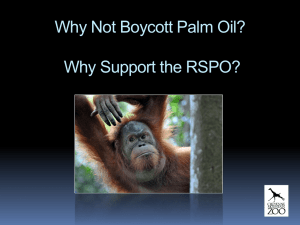
![Senior Supplier: [S Murphy]](http://s2.studylib.net/store/data/005470081_1-e104ea2fd5e2b6661eb586c19f7a89ca-300x300.png)
